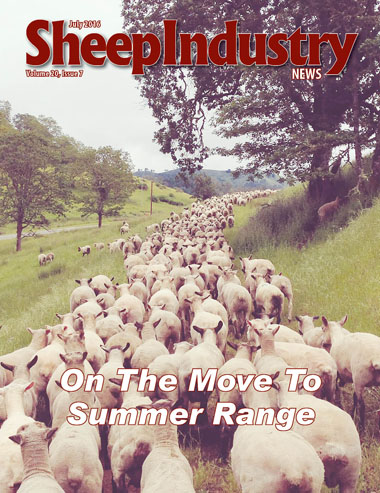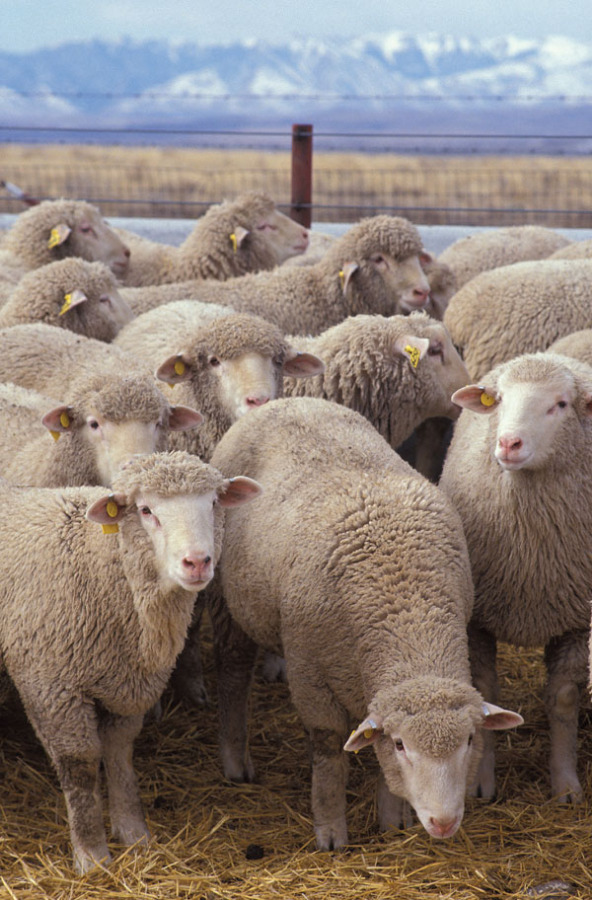
- July 2016
- President’s Notes
- Yellowstone Menus Offer Lamb
- ASI Comments on Behalf of USSES
- ASI Photo Contest
- Industry Recommends Research Priorities
- Sheep Center Sets Grant Deadline
- Sale Strengthens Lempriere
- Appropriations Update from Washington, D.C.
- Guaranteed for Life
- Young Entrepreneur: Sarah Spear
- CSU Vet Team Works Wyoming Ranch
- NSIP Offers Producers Online Tools
- Obituary
- Market Report
- Around the States
- The Last Word
ASI Comments on Behalf of USSES
As the U.S. Sheep Experiment Station in Dubois, Idaho, prepares to celebrate its 100th anniversary in August, ASI stepped forward with comments on behalf of the station in an effort to assure another 100 years of valuable sheep industry research.
In June, ASI filed extensive comments that pertain to the U.S. Sheep Experiment Station Grazing and Associated Activities Project 2016 Revised Draft Environmental Impact Statement as issued by the U.S. Department of Agriculture, Agricultural Research Service. Thoughts on the Draft EIS were originally due in early May, but the comment period was extended until June 16.
 “ARS has provided a critical venue for sheep breed development, evaluation and improvement,” read the written comments submitted by ASI Executive Director Peter Orwick. “Because the majority of America’s sheep are bred and raised west of the 100th meridian, mostly in the Intermountain West, the research and development conducted at the station is invaluable. For example, the station has made germplasm available to ranchers and has developed three of the most important sheep breeds – the Columbia, the Targhee and the Polypay. ARS has also conducted extensive research on the effects of fire on rangelands, the health and recovery of the sage grouse and its habitat, controlling invasive and noxious plants, and limiting impacts of livestock grazing practices on natural resources.
“ARS has provided a critical venue for sheep breed development, evaluation and improvement,” read the written comments submitted by ASI Executive Director Peter Orwick. “Because the majority of America’s sheep are bred and raised west of the 100th meridian, mostly in the Intermountain West, the research and development conducted at the station is invaluable. For example, the station has made germplasm available to ranchers and has developed three of the most important sheep breeds – the Columbia, the Targhee and the Polypay. ARS has also conducted extensive research on the effects of fire on rangelands, the health and recovery of the sage grouse and its habitat, controlling invasive and noxious plants, and limiting impacts of livestock grazing practices on natural resources.
“ASI fully supports selection of the preferred alternative as described in the Draft EIS as it allows the station to continue fulfilling its purpose.
“The purpose and need of the EIS are also defined by the mission of ARS and the station itself. ARS’s mission is to ‘conduct research to develop and transfer solutions to agricultural problems of high national priority and provide information access to and dissemination to:
• ensure high-quality, safe food and other agricultural products;
• assess the nutritional needs of Americans;
• sustain a competitive agricultural economy;
• enhance the natural resource base and the environment and provide economic opportunities for rural citizens, communities and society as a whole.’
“The Station, as it now operates, furthers this mission,” the comments state. “The station helps pursue the goal of providing abundant, safe and competitively priced animal products in a viable and sustainable way.”
Alternative 1 – the preferred alternative and proposed action – allows for the continued grazing of domestic sheep at all ARS lands, including headquarters pastures, Henninger and Humphrey Ranches, and East and West Summer Ranges, as well as on three National Forest Service allotments.
“This alternative allows the ARS to further its dual mission of, first, providing research and development of sheep breeding and production in the Intermountain West and, second, learning how to raise sheep in an environmentally-sensitive and sustainable manner so as to maintain the health and longevity of our rangelands and wildlife,” the comments state. “The station is the only research center of its kind in the country and it provides an invaluable service. Alternative 1 recognizes the station for what it is meant to be – an integrated research facility that seeks to better understand the interactions between the human world and its interface with the natural environment.
“As this letter discusses, the environmental impacts under the preferred alternative are limited and fully mitigatable with proper conservation measures. Under all other alternatives, ARS is required to unnecessarily sacrifice its research efforts without any benefit in return. Grazing, and its associated beneficial research, will be curtailed for no rational reason. As a result, the preferred alternative provides the best path for achieving the station’s mission.”
The Draft EIS proposed four additional alternatives with respect to grazing at the station, which included: no grazing, no grazing in the Centennial Mountains, the grizzly bear alternative and the bighorn sheep alternative. Each of these options would severly hamper the station’s ability to develop a better understanding of sheep production in this climate, thereby defeating the purpose of creating the station in the first place.
Alternative 2 – no grazing – would completely eliminate the station’s ability to carry out its assigned task of researching sheep production in the Intermountain West. A majority of the nation’s sheep are produced in this area, so the station is the only ARS location that can address range sheep and grazing in this climate.
“Without the ability to graze sheep, the station’s efforts to further its mission will be significantly hampered, if not precluded altogether.”
Reduced grazing, as proposed in Alternatives 3, 4 and 5, would require reduced sheep numbers on the available land.
“The negative impacts of Alternative 3 would be significant. The reduction in sheep numbers would severely limit the station’s ability to conduct the sheep production research it is responsible for carrying out,” read the comments. “Additionally, a reduction in sheep numbers and curtailment of grazing would impede the station’s efforts to develop sustainable rangeland practices.”
Protections offered for grizzly bears in Alternative 4 are no longer applicable, since the U.S. Fish and Wildlife Service announced a recent proposal to remove the grizzly bear from the list of endangered and threatened species.
“Not only is the grizzly bear no longer in need of heightened protection, the species was able to fully recover as the station’s activities continued,” the report states. “Limiting these activities under Alternative 4, or any other alternative, is not necessary.”
Alternative 5 was developed with bighorn sheep in mind.
“The agency developed Alternative 5 in response to public suggestions that grazing be eliminated to avoid interactions between domestic sheep and the Rocky Mountain Bighorn Sheep. Under this alternative, grazing on the Snakey-Kelly allotment would be discontinued and sheep would be kept and fed harvested feed at the Mud Lake Feedlot during winter months. To accommodate this change, sheep numbers would be reduced from 3,000 to 2,000,” the report states.
“This alternative marginally limits direct and indirect impacts that are minimal to begin with. The closest bighorn sheep herd’s core habitat is 20 miles away from the station lands. The possibility of contact between the station’s domestic sheep and the distant bighorn sheep is extremely limited. Effective conservation measures and an adaptive management protocol are in place to prevent even a remote possibility that disease transmission may occur on the Snakey-Kelly allotment while domestic sheep are present.
“Further, there is an even lesser chance, under the preferred alternative, that bighorn sheep would actually come into contact with domestic sheep in a manner sufficient enough to result in transmission of any respiratory disease-associated bacteria that are not already carried by the bighorn sheep. Limiting grazing under Alternative 5 would do little to protect bighorn sheep populations. At the same time, Alternative 5 would prevent the station from furthering its mission.
“The agency concluded that, under Alternatives 1, 3 and 4, the potential interaction between domestic and bighorn sheep ranged from non-existent to minimal,” the report states. “Discontinuing grazing on the Snakey-Kelly allotment would eliminate one theoretical instance where bighorn sheep might acquire microbial agents. However, it would likely not eliminate the chances of respiratory disease in bighorn sheep. Other factors determine the overall health of the bighorn sheep population, including endemic disease, other sources of disease, immunity to disease, nutrition, fragmented migration routes and limited winter ranges.
“Additionally, limiting sheep to the Mud Lake Feedlot, as is proposed under Alternative 5, would impair the station’s ability to further its dual mission of evaluating genetic development of sheep in the arid mountain west and developing sustainable range management systems. The station also provides a context in which to research and better understand the interactions between domestic and bighorn sheep and to develop ways to minimize and mitigate potential negative effects of this interaction. Limiting sheep to the Mud Lake Feedlot would preclude this research.
“The potential benefit for bighorn sheep under Alternative 5 is limited, and the agency can more fully realize its statutory obligation and mission under the preferred alternative (Alternative 1).”
ASI’s comments go on to address various environmental issues, including the range, soils and hydrology, as well as further detail on how the station can balance domestic sheep grazing with the needs of grizzlies, bighorns and even sage grouse.
A final decision on the future of the station is expected 75 to 90 days after the comment period closed, meaning sheep producers should know more by early to mid-September.
To read the full comments submitted by ASI, please visit Sheepusa.org/IssuesPrograms_Issues_SheepExperimentStation.

